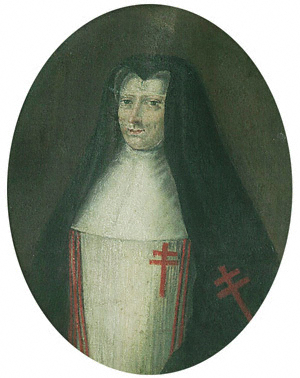Mary Dennett (prior) facts for kids
Quick facts for kids
Mary Dennett
|
|
|---|---|

portrait by an unknown person
|
|
| Born | 1730 |
| Died | 12 July 1781 |
| Nationality | Great Britain |
| Other names | name in religion was Christina |
| Occupation | nun |
| Known for | prioress of the Holy Sepulchre, Liège |
Mary "Christina" Dennett (born 1730, died 1781) was an important British nun. She was the leader, called a prioress, of a group of nuns known as the Canonesses Regular of the Holy Sepulchre in Liège. This city is now in Belgium. Mary Dennett led the convent from 1770 to 1781. While another nun, Susan Hawley, is often credited with starting the school connected to the convent, it was Mary Dennett who made the school famous around the world in the 1700s. This happened long before the school moved to England in 1794.
Contents
Early Life and Becoming a Nun
Mary Dennett was born in 1730 in Appleton, near Widnes, England. Her father, Henry, was a Protestant, and her mother, Mary, was a Catholic. Mary was the youngest of four children. When her father passed away when she was about five years old, she was raised as a Catholic.
In 1746, Mary went to the convent in Liège. Her sister was already a nun there. Mary was very dedicated to a religious life. It is said she decided to live a life of purity when she was only ten. The convent in Liège was started in 1642 by an English woman named Dame Susan Hawley. She became the first prioress in 1656. Mary Dennett was too young in 1746 to become a nun right away. So, she was sent to get an education at a school in Liège run by the Ursuline nuns.
Leading the Convent and School
Mary Dennett became the assistant leader, or sub-prioress, in 1769. Then, in 1770, she became the sixth prioress of the Holy Sepulchre convent. In her first year as prioress, she focused on the convent's school. The school had been around since 1651. However, Mary Dennett wanted to make it much better. She wanted it to offer an education for Catholic girls that was as good as any school in England.
At that time, there were laws in Britain called the Penal Laws. These laws made it difficult for Catholics to practice their faith openly or get a good education in England. The convent in Liège helped Catholic families by providing education for their daughters. Mary Dennett understood that many girls would come to the convent school, but not all of them would want to become nuns. She was determined that these girls would grow up to be well-educated wives and mothers.
Expanding the School's Reputation
To make the school better, a new school building was started in 1772. By 1776, another building was needed because there were sixty girls living and studying there. The school became very successful and well-known. It had always attracted English Catholic girls. But because of its growing reputation, girls from many different countries also started coming to study there.
The school offered important subjects like English, Maths, and modern languages. It also taught wider-ranging subjects, including debating and double-entry bookkeeping. This helped the girls learn useful skills for their future lives.
Death and Lasting Impact
Mary Dennett passed away in Liège in 1781. Today, New Hall School in Chelmsford, England, recognizes Susan Hawley for founding their school in 1642. However, it was Mary Dennett who truly helped the school gain its international reputation. It is said that when the convent had to move to England in 1794 to avoid the French Revolution, the school's strong reputation made it hard for them to leave Liège. One of the houses at New Hall School is named Dennett House, honoring her important contributions.

